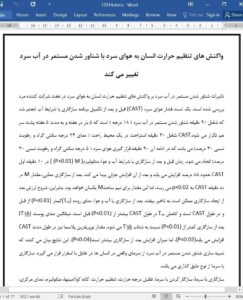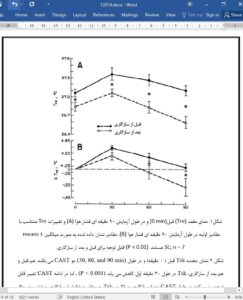YOUNG, ANDREW, J., STEPHEN R. MUZA, MICHAEL N. SAWKA, RICHARD R. GONZALEZ, AND KENT 13. PANDOLF. Human thermoregulatory responses to cold air are altered by repeated cold water immersion. J. Appl. Physiol. 60(5): 154% 1548, 1986.-The effects of repeated cold water immersion on thermoregulatory responses to cold air were studied in seven males. A cold air stress test (CAST) was performed before and after completion of an acclimation program consisting of daily 9O-min cold (U?‘C) water immersion, repeated 5 times/wk for 5 consecutive wk. The CAST consisted of resting 30 min in a comfortable [24”C, 30% relative humidity (rh)] environment followed by 90 min in cold (5°C 30% rh) air. Pre- and postacclimation, metabolism (dM) increased (P < 0.01) by 85% during the first 10 min of CAST and thereafter rose slowly. After acclimation, AI was lower (P c 0.02) at 10 min of CAST compared with before, but by 30 min 2M was the same. Therefore, shivering onset may have been delayed following acclimation. After acclimation, rectal temperature (T,,) was lower (P < 0.01) before and during CAST, and the drop in T,, during CAST was greater (P < 0.01) than before. Mean weighted skin temperature (Tsk) was lower (P < 0.01) following acclimation than before, and acclimation resulted in a larger (P < 0.02) T,,- to-T,, gradient. Plasma norepinephrine increased during both CAST (P < 0.002), but the increase was larger (P < 0.004) following acclimation. These findings suggest that repeated cold water immersion stimulates development of true cold acclimation in humans as opposed to habituation. The cold acclimation produced appears to be of the insulative type.
cold acclimatization; cold acclimation; hypothermia; thermoregulation; catecholamines; metabolism; core temperature: skin temperature
has been reasonably well demonstrated. For example, Korean women divers who repeatedly dive in cold water have been reported to have a higher threshold for shivering (lower critical water temperature) than nondivers (16, 19). Also, Australian aborigines and South African bushmen who have lived many years exposed nearly nude to extreme low temperatures at night respond to cold exposure with little or no shivering and lower steadystate core and skin temperature compared with control subjects (13). Nonadapted humans respond to acute cold ’ Throughout this report the term acclimatization will refer to the exposure with marked shivering and elevated metabolic heat production (13, 18). The degree to which persons lacking a lifetime experience of cold stress are able to acclimatize to cold is not known. Furthermore, while cold acclimation procedures have been reported to produce altered responses to cold (3, 11, l&14,17, ZO), the extent to which such changes represent habituation (blunted response) as opposed to true acclimation remains unclear.











